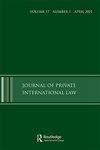Domestic violence and inter-country child abduction: an Indian judicial and legislative exploration
IF 0.5
Q3 LAW
引用次数: 2
Abstract
The Hague Convention on the Civil Aspects of International Child Abduction aims to prevent the abduction of children by their parents by ensuring the child's prompt return to his/her place of habitual residence. At the time of drafting the Convention, the drafters believed that non-custodial parents who were fathers perpetrated most of the abductions. However, the current statistics reveal the overwhelming majority of all abductors as primary or joint-primary caretakers. Unfortunately, it is unknown what exact proportion of these situations includes abductions triggered by domestic violence. In the absence of an explicit provision of domestic violence against spouses as a defence against an order of return, for a parent who has abducted a child to escape domestic violence, the relevant defence is of “grave risk of harm” to and “intolerable situation” for the child under Article 13(1)(b) of the Convention. However, the lack of guidance on what constitutes “grave risk” and “intolerable situation”, at least in the past, and its operationalisation in the context of domestic violence brings in pervasive indeterminacy in child abduction. In 2012, the Hague Conference on Private International Law identified “domestic violence allegations and return proceedings” as a key issue and recommended steps for developing principles on the management of domestic violence allegations in return proceedings leading to the adoption of a Good Practice Guide on this issue in 2020. The Ministry of Women and Child Development (WCD) and the Ministry of Law and Justice, India, cite that most Indian parents who abduct their children happen to be women escaping domestic violence abroad. Thus, they are victims escaping for themselves and their children's safety. This research has summed up the judgments delivered by High Courts and the Supreme Court of India on child abduction between 1984 and 2019. Through judicial mapping, the paper discusses the cases in which battered women have highlighted and argued domestic violence as a reason against their children's return. The paper evaluates whether the reason given by the two ministries against India's accession to the Hague Convention is reflected in cases that have come up for judicial resolution and what are the criteria evolved by the judiciary in addressing the concerns of domestic violence against a spouse involved in child abduction. The paper analyses India's legislative initiative, the Civil Aspects of International Child Abduction Bill, 2016 and assesses the measures proposed by the Bill for considering domestic violence against a spouse in abduction cases.家庭暴力和跨国绑架儿童:印度司法和立法探索
《关于国际儿童拐骗的民事方面的海牙公约》旨在防止父母拐骗儿童,确保儿童迅速返回其惯常居住地。在起草《公约》时,起草者认为,大多数绑架行为都是由非监护父母作为父亲实施的。然而,目前的统计数据显示,绝大多数绑架者是主要或共同的主要看护人。不幸的是,目前尚不清楚这些情况中包括家庭暴力引发的绑架的确切比例。在没有明确规定对配偶实施家庭暴力作为对遣返令的辩护的情况下,对于绑架儿童以逃避家庭暴力的父母来说,根据《公约》第13条第(1)款(b)项,相关辩护是对儿童的“严重伤害风险”和“无法容忍的情况”。然而,至少在过去,缺乏关于什么是“严重风险”和“无法容忍的情况”的指导,以及在家庭暴力背景下的操作,导致了绑架儿童的普遍不确定性。2012年,海牙国际私法会议将“家庭暴力指控和遣返程序”确定为一个关键问题,并建议采取步骤制定遣返程序中家庭暴力指控的管理原则,最终于2020年通过了关于这一问题的《良好做法指南》。印度妇女和儿童发展部和法律与司法部指出,大多数绑架孩子的印度父母恰好是逃离国外家庭暴力的妇女。因此,他们是为了自己和孩子的安全而逃离的受害者。这项研究总结了印度高等法院和最高法院在1984年至2019年间对绑架儿童的判决。通过司法绘图,本文讨论了被殴打妇女强调并辩称家庭暴力是阻碍其子女返回的原因的案件。该文件评估了两个部委提出的反对印度加入《海牙公约》的理由是否反映在有待司法解决的案件中,以及司法部门在解决涉及绑架儿童的配偶遭受家庭暴力的问题时制定了哪些标准。该文件分析了印度的立法举措《2016年国际儿童拐骗案的民事方面法案》,并评估了该法案为考虑拐骗案中针对配偶的家庭暴力而提出的措施。
本文章由计算机程序翻译,如有差异,请以英文原文为准。
求助全文
约1分钟内获得全文
求助全文

 求助内容:
求助内容: 应助结果提醒方式:
应助结果提醒方式:


